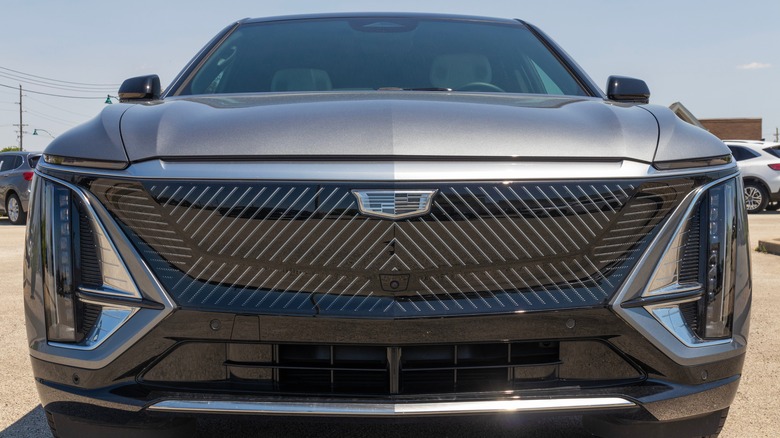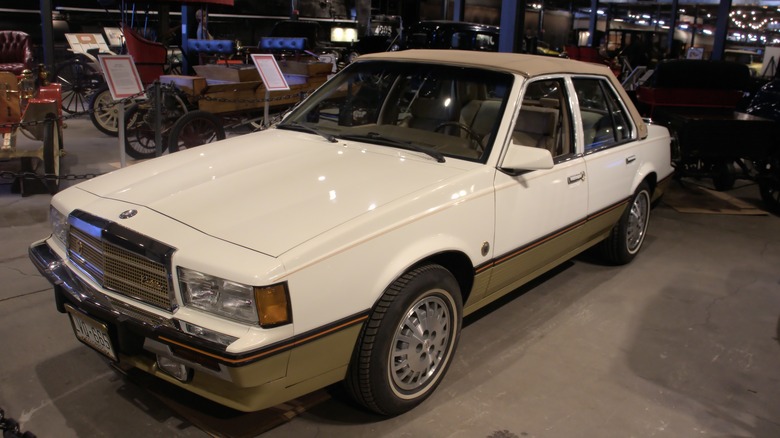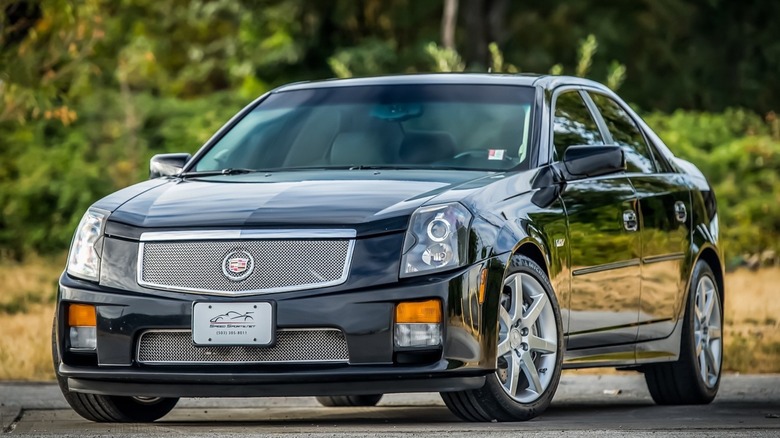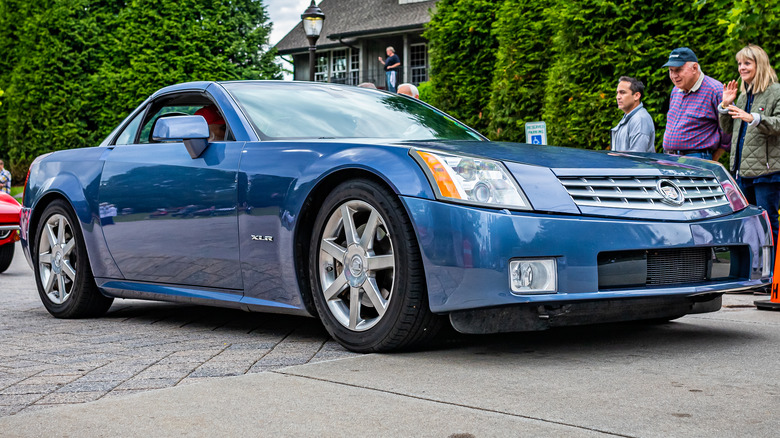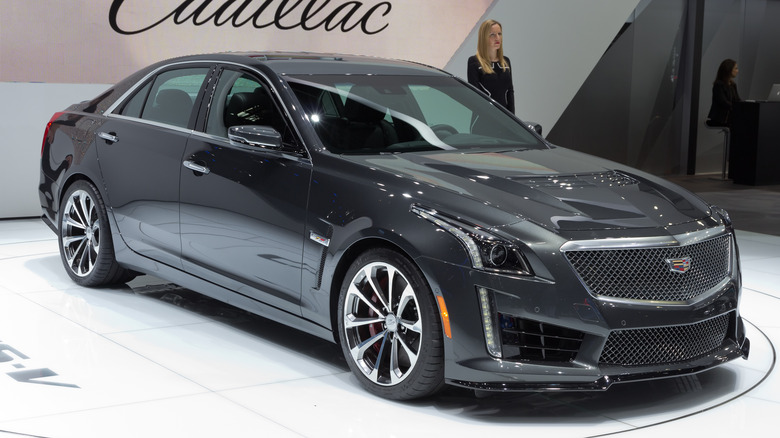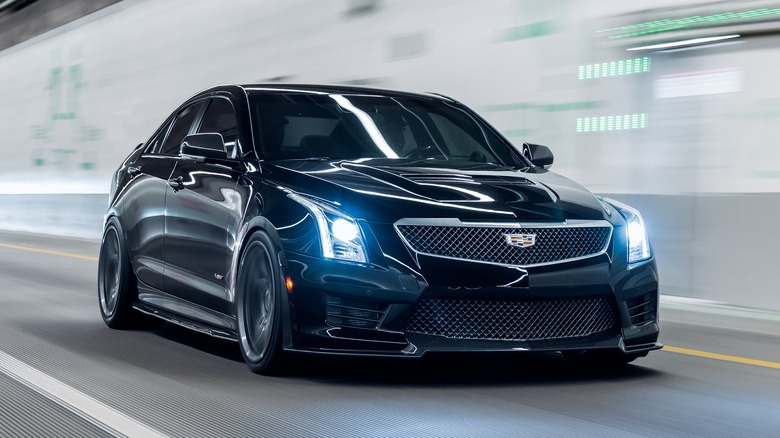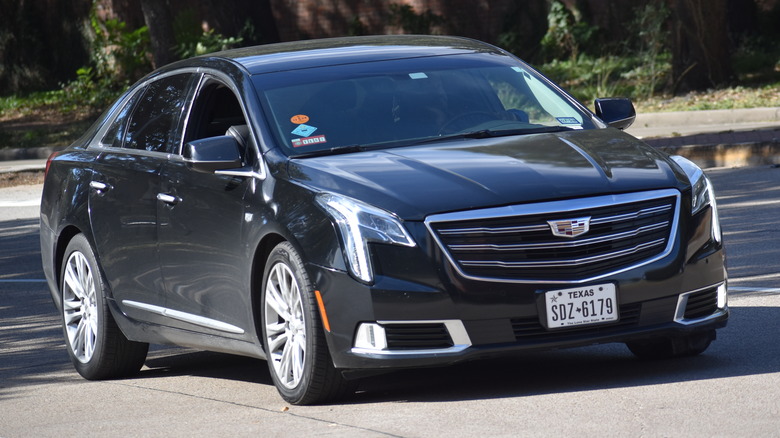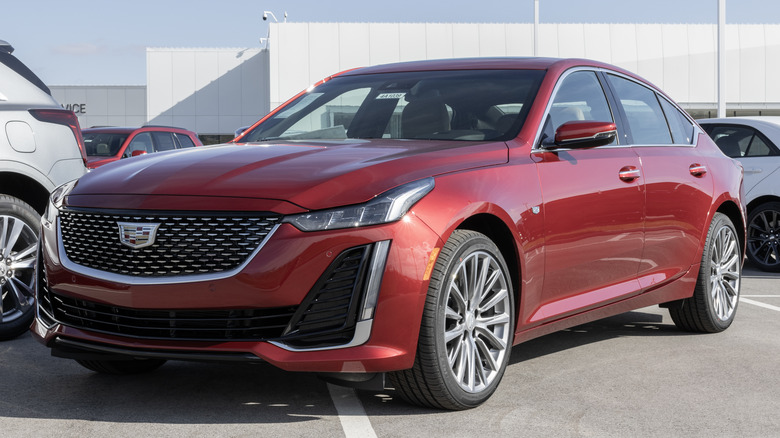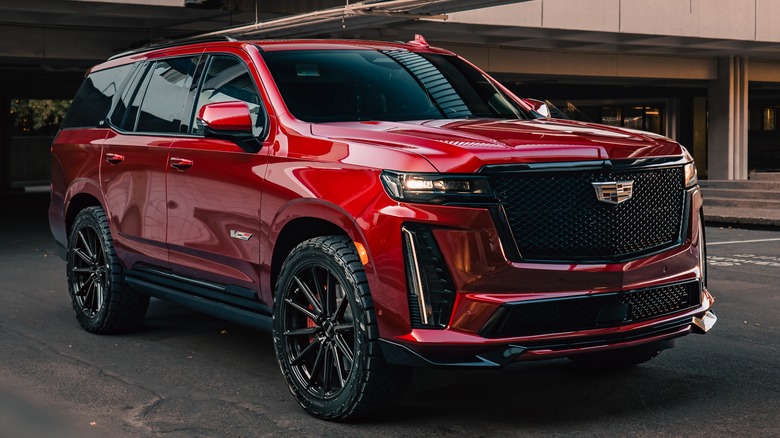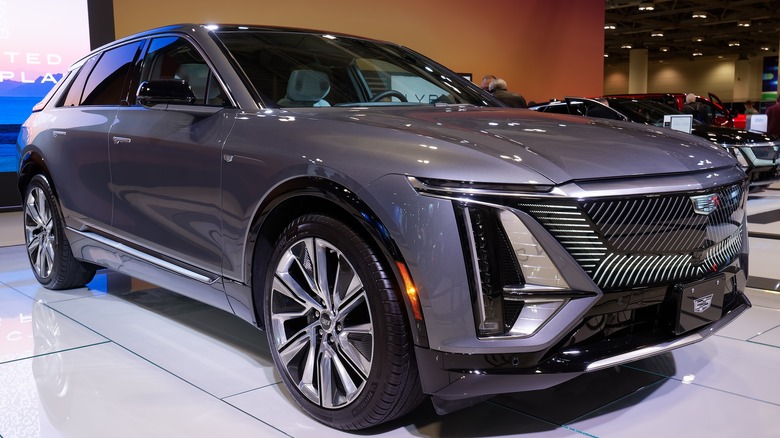Power And Prestige: The History Of Cadillac's High-Performance Models
Ford wanted a car in every garage. Chevrolet aimed to design a car for "every purse and every purpose." BMW bills itself as the "ultimate driving machine." But Cadillac has always been about luxury. Amongst the first automakers to offer a fully enclosed cabin, electric ignition, and interior lighting, the fledgling GM division became known for being a cut above some of the simpler and more affordable designs.
However, while Cadillac remained a byword for premium automobiles through the 20th centry, but there was one arena it never really entered: performance vehicles. Aside from a brief appearance in the 1950 24 Hours of Le Mans, in which a Cadillac built by Briggs Cunningham placed 10th, Cadillac and the sports car world have never really cohabitated. By the 1950s, Cadillac cars were known for being enormous (during an era of already enormous vehicles), smooth, luxurious, and powerful — but not particularly fast.
For decades, gas was cheap, bigger was better, and wealthy celebrities drove Cadillacs. Having an El Dorado or a Fleetwood in the garage meant you had made it. But the turn of the 20th century saw Cadillac shift focus to a new target: European sports sedans.
A shift in strategy
The 1980s started well, but with competition from imports heating up, the huge thirsty Cadillacs began to lose market share. The low point may be the cheaply built and reviled Cadillac Cimarron — a car described by Motor Trend as "one of the worst cars ever." Between 1980 and 1990, Cadillac dropped from 31% to 22% market share — nearly a percentage point per year. It was a dark decade for the once-prestigious brand.
Cadillac was slow to get the message. The perception that Cadillacs were for senior citizens driving 15 mph below the speed limit with their turn signal on prevailed through the nineties. The NorthStar 90-degree V8, coupled with suspension upgrades and a smaller overall vehicle size, indicated that Cadillac might be inching toward the root of the problem. To add insult to injury, not only did Cadillac suffer from a reputation for being past its prime, but luxury competitors like Lexus and BMW were earning increased shares of the luxury market.
The introduction of the Cadillac Escalade in 1999 may have staved off disaster. Based on the Chevrolet Tahoe, the luxury full-sized SUV caught the imagination of the wealthy and famous, name-dropped in songs and driven by Tony Soprano. Sales started to tick upward, with young consumers suddenly more aware of the brand. Yet it was not enough. Luxury competitors offered comfort, handling, and power wrapped into one neat package. If Cadillac wanted to keep up, it would need to do the same.
The rise of the modern performance Cadillac
The Cadillac Catera, a reskinned Opel Omega built in Germany, was foisted upon the public as "the Caddy that zigs." Unfortunately, it should have zagged. Hemorrhagging sales and suffering from a major image problem, Cadillac desperately needed a complete reimagining, and Designer Kip Wasenko was just the man for the job.
A GM veteran since 1968, Wasenko had served as chief designer at Saturn, Chevrolet, and Oldsmobile. In late 1997, Cadillac tapped Wasenko as the lead designer in developing a performance concept that became the 1999 Cadillac Evoq (pronounced evoke). Razor-sharp, with sweeping lines and angular planes, the two-seater was powered by a 258 cubic inch V8 with 405 hp.
Although the Evoq never made it to full production, it inspired a line of performance Cadillacs that carried the beleaguered company into the 21st century. Twenty-five years later, the design cues of the Evoq remain easily identifiable in Cadillac's premier performance offerings.
Cadillac took a square aim at competitors like Acura, Lexus, BMW, and Mercedes with the 2003 debut of the CTS. A year later, it pulled the trigger with the 2004 Cadillac CTS-V. The V stood for... well, it depends on who you ask. Message boards claim it means everything from victory to voracious to velocity to vroom. Some claim a focus group simply found the letter V "unique and elegant," but the important thing is that the V would represent Cadillac's new pinnacle of performance.
Cadillac XLR (-V)
Strangely, the car closest to the 1999 Evoq concept that birthed the V-badge did not get the badge. The Cadillac XLR, a two-seater sports car lifted directly from the Evoq blueprints and meant to battle the likes of the Mercedes SL55 AMG and Jaguar XKR, performed nonetheless.
Available across a single generation spanning from 2003 to 2009, the introduction of the XLR was perhaps the starting gun that signaled Cadillac's serious intent to participate in the performance luxury race. There's no doubt that it caught the attention of the auto world. It was a far cry from the Catera and even further from the land yachts of Cadillac's past.
With contemporary cutting-edge technology like xenon headlights, a heated steering wheel, and the option to customize the interior with alloys and wood of the consumer's choice, it was Cadillac's mix of luxury and performance. The 4.6-liter V8 put out a respectable 320 hp and 310 lb-ft of torque with a top speed of 155 mph.
Cadillac outdid itself by supercharging a 4.4-liter Northstar V8 and slapping a V-badge on the 2006 XLR. The resulting 443 hp accelerated the XLR-V to a 13-second quarter mile and sub-5-second 0-60 time. The XLR only had three more years to live, but Cadillac' would remain committed to beating the Europeans at the track with its performance sedans.
Cadillac CTS-V
The original CTS was a mid-sized sedan replacement for the Catera, but now that Cadillac was intent on zagging, engineers fed the car a 5.7 L LS6 V8 straight out of the C5 Corvette. With 400 hp and 395 lb-ft of torque, by 2005, the CTS-V could pull a sub-5-second 0-60 mph time despite drivers reporting wheel hop from a standstill. The wheel hop would prove the cause of a greater ailment — namely, the propensity for the differential to explode under the stress of the 'Vette powerplant.
Just the same, Cadillac doubled down on the second-generation CTS-V. By 2009, the differential had been beefed up, which is good because that 5.7-liter LS6 had been upgraded to a 556 hp 6.2-liter V8 with an Eaton supercharger — a defanged version of the Corvette ZL1's LS9. Caddy also addressed complaints of the first generation's stiff sport suspensions with a magnetic suspension to manage the considerable 4,145-pound curb weight.
The insanity continued with the third generation, which was on the market between 2016 and 2019. The final iteration of the CTS-V housed a supercharged LT4 V8, creating up to 640 hp — on par with the new Porsche 911 Turbo S and Lamborghini Huracan. Incredibly, Cadillac offered all three generations of the CTS-V with Tremec six-speed manual transmission for the true purists. Who wants a car with only two pedals, anyway?
Cadillac ATS-V
Cadillac decided the third generation CTS-V's huge V8 and power output might not be for everyone — 640 hp is a lot to handle, fancy magnetic suspension or no. Cadillac saw what Mercedes, Audi, and BMW were doing and wanted a compact to keep up with them. The Cadillac family welcomed the ATS-V into the world in 2016.
Smaller and with a more sedate (if you want to call it that) 464 hp twin-turbo 3.6L LF4 V6, the ATS-V could actually outperform previous generations of the CTS-V. The ATS-V is shorter than its big brother, at 184 inches compared to 198 inches, but it retains the attitude that Cadillac wanted for its V-badge-marked cars. Though less powerful, the ATS-V beats the CTS-V with a 4-second 0 to 60 time due to its lighter weight of 3,760 pounds.
The ATS-V only had three years of production, but they were good years. Six-speed manual transmissions remained options, though an eight-speed automatic with paddle shifters was also available. While the car enjoyed a tragically short lifespan, Cadillac hopes to slot its spiritual successor, CT4-V Blackwing, into its line in the 2025 model year to make up for it.
Cadillac CT6-V
With the ATS-V filling the compact class and the mid-size CTS-V, Cadillac slotted the CT6 into its flagship full-sized sedan slot. The CT6 was produced between 2016 and 2020, with the V-badge arriving for the 2019 model. Toned down from the CTS-V, the 4.2 L twin-turbo Blackwing V8 puts 550 hp to the pavement, cuts a 12.2-second quarter mile, and gets up to 60 mph in 3.8 seconds.
Unfortunately for Cadillac, emissions issues caused delivery delays, which compounded the ails of the ill-fated sedan. The CT6 had a short four-year lifespan between 2016 and 2020, with the limited Blackwing seeing small numbers before the car got the ax. For the two years of CT6-V Blackwing production, Cadillac only built about 1400.
Cadillac cut production on the CT6 for a couple reasons. One was poor sales, and the other was that Cadillac began retooling the CT6 assembly lines to produce electric cars. If a full-size American performance sedan with an internal combustion engine is on your wish list, the opportunity to score one is dwindling. Despite Chinese production that outlasted American assembly lines, these cars are only getting rarer.
Cadillac CT4-V/CT5-V Blackwing
The ATS-V and CTS-V got the plugged pulled on them after the 2019 model year. But that doesn't mean Cadillac is giving up on its European competition strategy. The V-sport brand has been shortened to simply "V," and the highest honor for a Cadillac is to be labeled a Blackwing. Getting inspiration from the black merlette birds that adorn the Cadillac crest, Blackwing is the absolute best Cadillac has to offer — and the bump in MSRP reflects that.
The CT4-V Blackwing replaced the ATS-V for the 2020 model year. It stuck with the 472 horsepower twin-turbo V6, while the CTS-V has morphed into the CT5-V Blackwing with a 668 hp supercharged 6.2-liter V8. They don't sound that much different than their predecessors, so what gives? The options, that's what.
Brand-new buyers can load up their Blackwings with optional paint, carbon ceramic brakes, a 10-speed automatic transmission, high-level trim packages, upgraded interior materials, and all sorts of other toys that top out the luxury.
2024 MSRP has the CT4-V starting at $59,990 while the CT5-V demands $84,990. It's not a small amount of money, and loading up the options sends it north fast, but it's still very competitive for the likes of their European counterparts.
Cadillac Escalade-V
The almighty behemoth Escalade gave Cadillac the boost it needed to enter the performance sedan game at the turn of the century and remains a household name today. Luxurious, somewhat impractical, enormously expensive, and a bona fide status symbol, the gargantuan Escalade is perhaps the Cadillac most closely associated with its reputation of the past
Interestingly, the Escalade V didn't receive its full treatment until 2023, a staggering 25 years after its debut. Priced from $150,000, the Escalade V is a heavyweight at 6,217 pounds. Powered by a supercharged 6.2-liter V8 engine straight from the C7 Corvette, boasting 682 hp and 653 lb-ft of torque, the Escalade V offers a shiftable 10-speed automatic transmission and unparalleled comfort.
As Cadillac electrifies, it seems the Escalade V might die as soon as it was born. The carmaker unveiled an all-electric version, the Escalade IQ last summer. The end of the internal combustion is upon us, for better or for worse.
The future for Cadillac
What makes Cadillac's late adoption of a performance-oriented strategy is so enticing is that it represents the height of an era. General Motors and other builders are increasingly shifting toward electrification. With it comes the end of a century of automotive building that shaped society.
Since 1909, Cadillac has had the resources of General Motors at its fingertips, including some of the most powerful engines and revolutionary suspensions known to humanity. With manual transmissions and internal combustion slipping away, the late model Cadillac V-series cars represents what may be the last, greatest, and most technologically advanced V8 engines and manual transmissions to ever be built.
Sure, there's a little time left for internal combustion, but the end is nigh. There's every possibility these Cadillacs will not only be fondly remembered relics of times past but the final and finest vestiges of what engineers, artists, and scientists can do with good ol' fashioned American V8 power.
